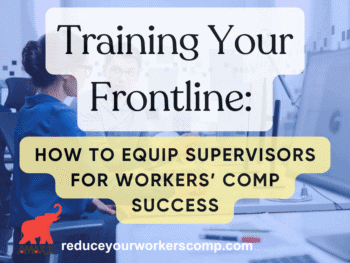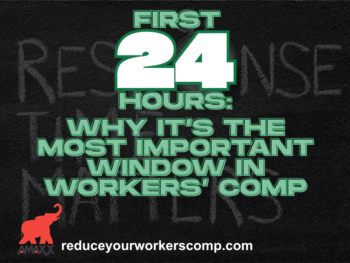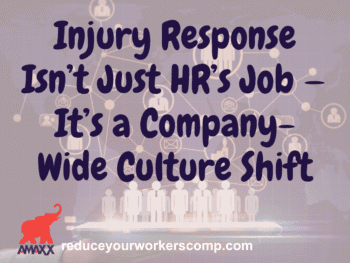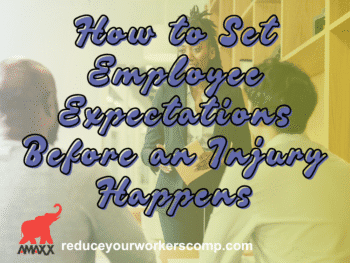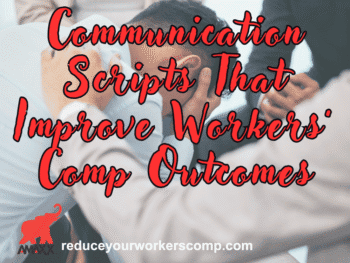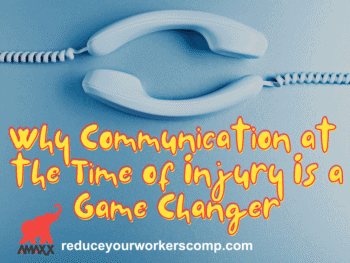
Employers, in their efforts to control workers’ compensation claim costs, often go to great lengths to manage their safety program, provide medical management, and analyze data. Employers also often incorporate computer programs with the latest technology in their quest for work comp cost control. All of this is good, but employers often overlook one of the simplest ways to control claim cost – staying in touch with the injured employee.
Work Comp Communication Should Start At Date of Hire
As a part of the new hire package, every employee should be told what to do in the case of an on-the-job injury, including how to report the injury to the employer and the requirement to continue the communications after the injury. This sets the stage for on-going communication with the employee when a work comp injury occurs.
Communication with the injured employee is of utmost importance from the moment the injury occurs until the last aspect of the worker’s compensation claim is concluded. When an accident happens, the first focus should be on the immediate medical needs of the injured employee. Communication at this point should be limited to the question of what happened, and if immediate medical attention is needed.
If the injury is severe, the workers’ compensation coordinator or the employee’s supervisor should accompany the injured employee to the emergency clinic or hospital. The work comp coordinator should contact the employee immediately following the initial doctor’s visit to determine the diagnosis, the prognosis, the treatment plan, and the injured employee’s work restrictions.
Click Link to Access Free PDF Download
“9-Element Blueprint To Create Your Workers’ Comp Employee Brochure”
Employees Hire Attorneys Due To Lack of Communication
The most needless way of dramatically increasing the cost of a workers’ compensation claim is to ignore an injured employee, causing the employee to hire an attorney. There are three primary reasons injured employees hire attorneys. They are conflict, fear, and greed.
- Conflict: The injured employee gets into a dispute with either the employer or the adjuster. Conflict normally occurs when all necessary information about the claim handling process has not been provided to the employee. By communicating frequently and completely with the employee, conflict can be avoided.
-
- Fear: The employee is concerned about his/her future employment, his/her future income, and/or his/her ability to provide for his/her family.
- Greed: The employee sees the accident as a way to gouge the employer or insurer for some extra money.
There is not much an employer can do about an employee’s level of greed, but an employer can prevent most employees from hiring an attorney by staying in touch with them. When employers have on-going communication with injured employees, conflict and fear are greatly reduced or eliminated.
The immediate contact after the first doctor’s visit reassures the employee that the employer is concerned about the employee’s wellbeing. It also lets the employee know that the employer is keeping the employee’s job for him/her, and the employer wants the employee back at work when the employee is physically able to return to work.
If the injured employee is not released to return to work following the initial medical provider visit, the employer must make a point of staying in touch with the injured employee. The injured employee can be instructed to phone the work comp coordinator following each doctor’s visit to advise what the doctor’s treatment plan is. Also, the employee should be reminded that he/she is still required to attend all employee/staff meetings if the employee is physically capable of doing so.
Regular Contact Reassures Employee They Are Still Wanted At Work
The work restrictions provided by the doctor should be reviewed and discussed with the employee. If at all possible, a transitional duty job within the boundaries of the work restrictions should be provided to the employee. The work comp coordinator should also be in touch with the adjuster and the medical provider to be sure the adjuster and medical provider are aware a transitional duty job is being provided to the employee.
On-going communications with the injured employee should continue for as long as the employee is off work, even with severe injuries where the employee is off for an extended period of time. By continuing regular contact with the injured employee, the employee is reassured that the employer does want him/her to return to work.
Staying in touch maintains the employee’s morale, builds rapport with the employee, keeps the employee from hiring an attorney, and lowers the overall cost of the workers’ compensation claim. Employers should make staying in touch with the injured employees a central tenet of their work comp cost control program.

Contact: RShafer@ReduceYourWorkersComp.com.
Workers’ Comp Roundup Blog: https://blog.reduceyourworkerscomp.com/
©2020 Amaxx LLC. All rights reserved under International Copyright Law.
Do not use this information without independent verification. All state laws vary. You should consult with your insurance broker, attorney, or qualified professional.





